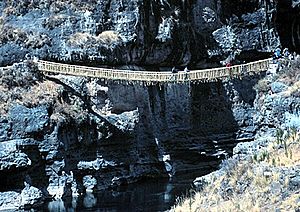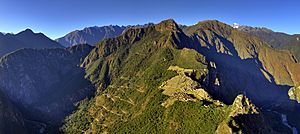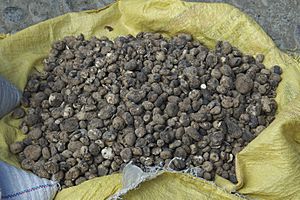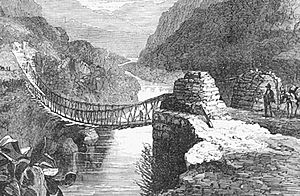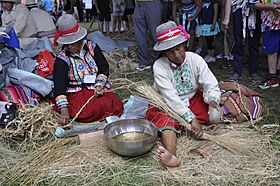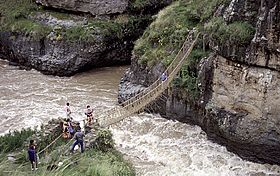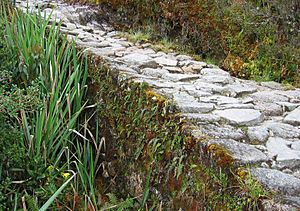Incan engineers facts for kids
The Incan engineers were skilled builders. They created most of the amazing structures and roads in the famous Inca Empire. Their work helped the empire grow and connect its people.
Contents
Building with Water: Hydraulic Engineering
Incan engineers were masters of water. They designed and built impressive water systems in their cities. These included canals, fountains, and drainage systems. They also made huge irrigation systems for farming.
Experts carefully chose where to build major Inca cities. They planned the city's layout and how water would flow. For example, in the city of Tipon, engineers built three irrigation canals. These canals brought water from the Pukara River to the farm terraces. Tipon also had natural springs. The Incas built fountains there to provide clean water for people, not just for farming.
Machu Picchu: A City on a Mountain
The famous city of Machu Picchu was built around 1450. It shows how advanced the Incas were in civil and water engineering. This city is known today for being well-preserved and beautiful.
Machu Picchu sits high on a mountain, about 120 km northwest of Cusco in Peru. It's 2,560 meters above sea level! The engineers had to plan carefully because of the steep slopes and rainy weather. They built the city on terraces, mostly for farming. Machu Picchu also has special living areas for important people and religious buildings. Many staircases and carved rocks are part of its unique design.
Before building, engineers made clay models. They also checked if the local spring could provide enough water for everyone. After confirming the water supply, they designed a long canal. This canal brought water down the mountain, through the farming areas, and into the city center. It fed a series of public fountains. These fountains had stone spouts that made a perfect jet of water for filling clay jugs. The water then flowed from one fountain to the next.
The Incas built these canals with a steady slope using cut stones. Most people helped build and maintain these water systems. They used bronze and stone tools to make the canals watertight. The water flowed through 16 fountains, called the "stairway of fountains." The first fountain was reserved for the Emperor. This amazing system supplied water for 300 to 1000 people and helped water the farm terraces. These fountains and canals were so well built that they could still work today with a few repairs!
Machu Picchu also had an impressive drainage system. About 130 outlets helped move water out of the city. The farm terraces were part of this system. They were built on slopes to direct extra water into channels. These channels ran alongside stairways and carried runoff away from the main water supply. This careful planning showed how much the Incas valued clean water.
Terraces: Farming on Slopes
The Inca people lived in areas with very steep land. This caused two big problems: soil erosion and not enough flat land for crops. Their solution was to build Andenes, or terraces. These terraces allowed them to farm land they couldn't use before.
How Terraces Work
The design of each terrace depended on the slope of the land. What made them so successful was their special layers. First, there was a base layer of large rocks. Then came a layer of smaller rocks, followed by a sand-like material. Finally, the topsoil was added.
The drainage system of the terraces was also very clever. Drain outlets were placed in the stone walls. The large rocks at the bottom of each terrace level allowed water to flow easily through them. This water eventually went into a "Main Drain." The Incas even built different types of drainage channels for various uses around their cities.
Building and Benefits of Terraces
To build a terrace, the Incas first dug into the hillside. Then, they filled the space with layers of materials. A strong stone wall was built to hold everything in place. This wall had many uses. It absorbed heat from the sun during the day and released it at night. This often kept crops from freezing in the cold mountain nights.
Because the soil on the terraces was level, water didn't rush down the mountain. This prevented erosion, which could wash away roads and fertile soil. Since the soil stayed in place, nutrients from old crops would enrich it year after year. The Incas even planted specific crops together to help each other grow. For example, they planted corn, beans, and squash together. The beans added nitrogen to the soil, helping the corn. The squash acted like a cover, keeping the soil moist and stopping weeds.
Freeze-Drying: Preserving Food
The Inca people could freeze-dry all their food, whether it was grown or hunted. Freeze-drying is still popular today! It removes all the water and moisture from food but keeps all the nutrients. Removing water also makes food much lighter. This was great for carrying food long distances and for storing it, as dried meats lasted twice as long as fresh ones.
Vegetables and Meats
The Inca diet was mostly vegetarian. Large wild game was usually saved for special events. A very common freeze-dried food was the potato, which they called Chuño when frozen.
Common meats they freeze-dried included llama, alpaca, duck, and guinea pig. Dried meat, called ch'arki in Quechua, was much easier to transport and lasted longer than fresh meat.
The Freeze-Drying Process
Both meats and vegetables went through a similar process. The Incas would lay the food on rocks. During the cold nights in the high altitudes with dry air, the food would freeze. The next morning, the thin, dry air and the sun's heat would melt the ice. The water would then evaporate, leaving the food dried.
This freeze-drying process was very important for moving and storing food. The high elevation and low temperatures of the Andes mountains made it possible for them to do this naturally.
Inca Pathway Systems
The Inca Empire was huge! So, they needed excellent transportation systems. These systems helped them exchange goods, services, and allowed people to travel. The empire stretched about 3500-4000 km along the mountains of South America. The trails, roads, and bridges not only connected the empire physically but also helped them communicate.
Rope Bridges: Crossing Gorges
Rope bridges were a key part of the Inca road system. Five centuries ago, there were hundreds of these suspension bridges in the Andes. They connected two land masses, allowing people, goods, and animals to cross deep gorges. Inca rope bridges could span longer distances than any European stone bridges at the time! Since the Incas didn't use wheeled vehicles, most people traveled on foot or with animals.
How Rope Bridges Were Built
These bridges were made from twisted mountain grass, other plants, and saplings. Even though they were made of natural materials, they were very strong. They could hold the weight of travelers and animals, and withstand weather for a time. Because grass rots, the bridges had to be rebuilt every year.
First, the Inca people gathered grass and other plants. Women braided these into thin ropes. Villagers then brought their ropes to the builders. These thin ropes were twisted together to make thicker cords. Then, these cords were braided into huge cables, some as thick as a person's body! These heavy cables were then taken to the bridge site.
Men were in charge of building the bridge on site. A builder would go to the other side of the gorge. A thin, light rope was thrown across to them. This rope was then used to pull the main cables over the gorge. Stone beams on each side of the gorge helped hold and tighten the cables. Once the cables were secure, workers carefully crossed them. They tied the foot-ropes together and connected them to the handrails using the thinner ropes. Some bridges also had pieces of wood woven into the foot-ropes.
Today, rope bridge builders in Peru still make offerings to "Mother Earth" to ensure the bridge is strong. This might have been a practice used by the Inca people too. If everything went well, a bridge could be built in just three days!
Modern Rope Bridges
People today continue to honor Inca traditions by building and learning about rope bridges.
Every June in Huinchiri, Peru, four Quechua communities work together to build a new grass bridge. They cut down the old Q'eswachaka Bridge and let the Apurímac River carry it away. Then, they build a new one in its place. This tradition connects these communities to their Inca ancestors.
A replica of a 60-foot Inca rope bridge is on display at the Smithsonian’s National Museum of the American Indian in Washington, DC. This exhibit helps preserve and share knowledge about these amazing Inca-inspired bridges.
Students at the Massachusetts Institute of Technology have even learned to build these bridges. They made a 60-foot fiber bridge in the Peruvian style. This project helped them understand the Inca people's way of thinking and building.
Roads: Connecting the Empire
Inca roads covered over 40,000 km (25,000 miles)! They mainly had two main highways running north to south across the Inca Empire. These roads spread across ancient Peru, Ecuador, Chile, and Bolivia. Inca engineers were not stopped by difficult land. They built roads across canyons, rivers, deserts, and mountain passes as high as 5,000 meters!
Many of the discovered roads are about one to four meters wide. However, some roads, like a highway in Huanuco Pampa, could be much wider. Since the Inca people mostly traveled on foot, the roads were built for walking and running. Some roads were paved with stones or cobbles. Others were edged with small stone walls, markers, or piles of stones. Drainage was very important to the Incas. They built drains and culverts to make sure rainwater flowed off or under the road.
Uses of Inca Roads
The Inca roads had several important uses. The most obvious was transporting goods. People carried items on foot, sometimes with the help of llamas and alpacas.
Ideas and messages also traveled along these roads. The Incas used special messengers called Chasquis. These young men were chosen for being strong and fit. They ran many miles each day to deliver messages. The Chasquis rested in small buildings called "tambos" along the roads. These tambos could also house the Inca army if there was a rebellion or war.
Modern Inca Roads
Today, many people travel to South America to hike the Inca trail. Walking and climbing this historic trail allows visitors to experience the pathways of the Inca people. They can also see Inca ruins, beautiful mountains, and unique plants and animals.


